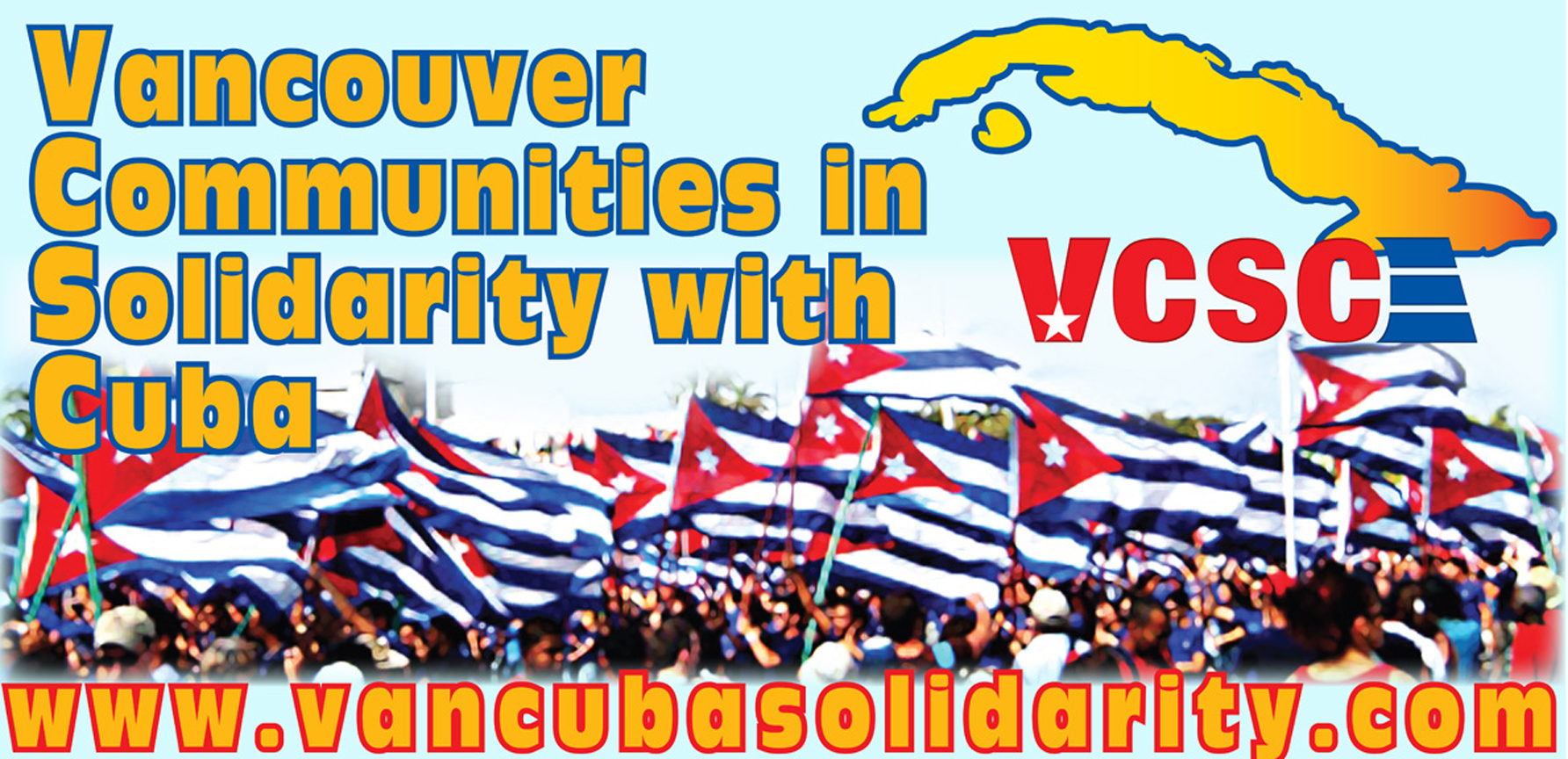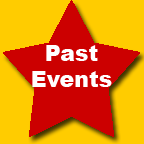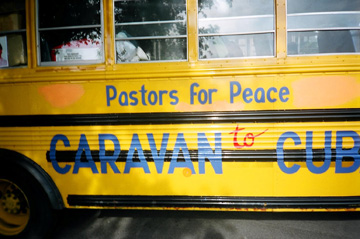




 Summer 2005
Summer 2005Visiting Cuba Through the Eyes of a Young Canadian Activist
A Memoir of a trip with Adventure, Education and Politics!
OR
How I Learned to Love Cuba!
First Appeared in the Fire This Time Newspaper
Part 2
By Sophie Ziner
The wheels of our plane hit the hot tarmac at the Jose Marti international airport in Havana, came to a stop, and with my heart beating hard in my chest, I climbed off the plane and set my feet- for the first time, on Cuban soil. The first thing to meet my eyes was a huge sign, running the length of the building in front of me reading “Patria es Humanidad”- Humanity is my Homeland. At the end of the nineteenth century Jose Marti said that short quote while fighting for Cuba’s independence from imperialist intervention. As I would learn over my next week in Cuba, this powerful idea has a presence everywhere in Cuba, and I would see its impact everywhere we visited.
The group I was traveling with, Pastors for Peace, is a US based solidarity group, which has traveled to Cuba collecting and bringing humanitarian aid through the US for the last 16 years, intentionally breaking the US law in a symbolic gesture against the US blockade of Cuba. Having crossed the US/Mexican border at Reynosa with 180 tons of aid, the 150 of us “Caravanistas” had gone on to Tampico, where the busloads of goods had been loaded onto barges, and we had boarded a plane and flew to Cuba (See FTT Vol. 3 Issue1- for the first part of my trip).
In Havana, I stayed in the Martin Luther King Memorial Centre, a Cuban organization that help co-organize the Caravan’s stay in Cuba, along with the Cuban Council of Churches and the Cuban Institute of Friendship with the Peoples (ICAP). It’s a big sunny building attached to a Baptist Church, with dormitory rooms. This is where we stayed for most of the trip.
Our bus into Havana brought us past carefully painted billboards, promoting not perfume and cell phones, but literacy, community, safe sex, volunteer work, organic gardening and mobilization. I noticed that there were people standing alongside the road, people in suits, people dressed for all sorts of work, and I asked someone if everyone was waiting for busses. They weren’t waiting for busses, they were hitchhiking- it turned out that in most cases, in Cuba it’s illegal not to pick someone up if you have space in your car!
Havana, compared to grey and rainy Vancouver, was full of colour and sounds, people and traffic, bikes, smoke and horns. Old buildings and old cars were interspersed with lush and expansive community gardens, mangos dripping off trees behind fences, red tomatoes peeking out through rows of beans. The Malecón, a long broad boulevard running the length of the shore in Havana, looked just like the pictures I had seen, only on the days we were visiting, it was not full of the millions of people marching in one of Cuba’s famous mobilizations.
The first few days in Havana were packed with events and visits. We got to visit churches, farms, schools, clinics; had evenings with cultural performances and dancing (one night we got a special performance from one of Cuba’s great hip hop crews- Anonimo Consejo which was incredible).
It was through these visits that we began to be introduced to the goals and principles that Cuba works with. The Cuba we were seeing was a place where peoples’ well-being was a priority. We learned about every thing from the programs to set up University satellite schools in remote areas, to the program where every child under the age of 7 is guaranteed one litre of milk a day. No Cuban we met was a millionaire. No Cuban we met owned a shipping company, or a sugar plantation or a chain of stores, personally. As it was explained to us, these things are not a priority in Cuba, the priority is to make sure everyone has the basic things they need to live with dignity, and to develop in good health.
We also got to see the limitations that the 46-year-old US imposed blockade of Cuba has brought. Costing the Cuban people an estimated $82Billion over the years, the blockade continues to prevent Cubans from accessing medical supplies, technological equipment, food, and many other much needed goods and services. Where Cuba has more doctors per capita than anywhere in the world, hospitals and clinics are still undersupplied with medicines and equipment- things as simple as disposable syringes and latex gloves. While school is free to everyone from kindergarten through post secondary, and universally accessible, books, computers, musical instruments are still limited.
And yet, Cuba develops its richest resource, people. And they don’t just do it to make Cuba better. Cuba sends tens of thousands of doctors and teachers and professionals all over the world.
During our third day in Cuba we visited the Latin American School of Medicine (ELAM). The school was out for the summer, but there were still some students and staff around. It’s this big huge complex of white buildings on the shore. It used to be a navel academy, but in 1998, as a part of the Battle of Ideas, it was turned into the medical school. The concept came out of the tragedy of the series of Hurricanes that year that killed over 30,000 people in Latin America, after which Cuba sent thousands of doctors and nurses to over 20 countries who had been stricken.
Dr. Luis Silva, the director of the school, talked about this in his introduction. He explained about how the Navel Academy had been up for sale as a resort, but how Fidel and Raul Castro had intervened and said that there was a need to set up an international school of medicine- so that Cuba could help Latin American and Caribbean countries, not just by sending them doctors, but also by training them for free and having them return to their communities permanently.
He talked about the spirit of internationalism that the school is founded on, how at first the school was only open to students from Latin America, but how they realized the effectiveness of the school and the need that people all over the world had for doctors and they expanded it to give spaces to students from any country. There are currently almost 4,000 students at the school, from 24 countries, with over 33 ethnic groups represented.
Incredibly, there are also 500 spaces available for US students, but because of the travel blockade and red tape the US administration puts up, there are only 71 American students at this time. August 1st, the first students graduated from the school. The school takes a holistic approach to medicine, training doctors on three principals- Academic Science, Social Commitment and Professional Development.
After the introduction, a young black woman got up and spoke. She was American, from West Philadelphia, which is one of the poorest neighbourhoods in all of North America, with the highest rate of crime and the highest percentage of adults who are functionally illiterate. She got up, and she had barely introduced herself when she started crying.
She talked about how she was never one of those kids who dream all their lives of becoming a doctor, because where she was from, it just isn’t on the list of possibilities, and now here she was at medical school, with a huge world opening before her. The school provides all upgrading needed, and Spanish courses so any applicant who shows an aptitude and seriousness can get in, regardless of their academic history. She was in her third year. She talked about moving to Cuba, living there, and going back to visit her sister last summer in Philly (the school pays for students to return home each summer), and the contrast between what she saw in America and what she saw in Cuba- Cuba being the 3rd world, America being the wealthiest country in the world. She talked about how when she graduates and goes back to Philly (the one requirement of the school, which covers all expenses for eight years of studying, is that when you graduate, you return to your community and practice there for two years) she’s not just going to be a doctor and provide community service with it, she going back with a spirit of internationalism and will also be working to advocate for the better world Cuba is trying to build.
It was a very moving speech- everyone was in tears by the end of it.
Later in the summer, upon returning home, I would see reports all over the news, about a horrible hurricane that ripped through the gulf states of the US. I would watch news reports showing thousands of poor, mostly black and latino people, their lives reduced to shambles, virtually abandoned by the government of the United States. I would also read about Cuba’s response to this tragedy- an offer to send 1,500 fully equipped doctors to assist the people of New Orleans, only for the US to turn this offer down. As I would read these things through August and September, I would think constantly of that young woman from Philly, and the offer that she accepted and why.
The impact of these visits, not just to the ELAM, but also to the other schools, the churches, the clinics, the farms, the community gardens, all of it- of seeing real life in Cuba, began to accumulate, on my fellow caravanistas and me. Questions were flying around- of “why Cuba?” How could a country, so small and under so much attack do such great things? And why? Why didn’t the countries we were coming from have the same values, the same institutions? What did Cuba have the United States didn’t have? Canada?
My mind kept coming back to the same thing, time after time- the first thing I saw in Cuba. “Humanity is my Homeland”. The foundation of the Cuban Revolution, the vision that the Cuban Revolution was built on- fighting for all human life- not just in Cuba, but also for every single person around the world.
One of the most viscous attacks that Cuba has faced since the revolution is the constant slander from the ruling class’s media in the US, including the accusation that Cuba is a violator of human rights. The people of Cuba are great at exposing the US on this accusation though- a friend I met told me
“Oh, there are human rights violations that take place in Cuba- they just all take place in the US military base in Guantanimo Bay.” (In Cuba you never see a flag at full mast, there is always space at the top, to remember that all of Cuba is not free because Guantanimo is still occupied and people are suffering there.)
I started to see that it went beyond that too though- that not only was the blockade of Cuba a horrible violation of these human rights that the US claim to treasure so much, but that the things that Cuba had fought for and gained in spite of this blockade were representing REAL human rights.
So why Cuba? What is so threatening about this island of 11.5 million people, in the middle of the ocean? What would compel the US government to attack it so fiercely?
The answers would begin to unfold as we got ready to celebrate the 26th of July, the national celebration of the revolution, with a speech by Fidel Castro himself at the Karl Marx theatre.
To be continued…
go to part III!